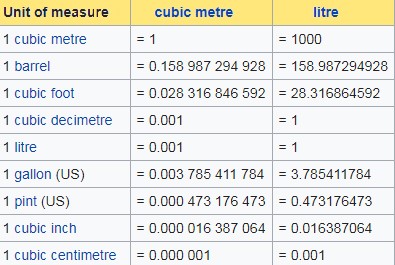In this article, students will learn about units of volume. Volume is the term that measures capacity and it mostly defines the volume of liquids. Students should know that the terms mass and volume are two different quantities. Let us learn the units of volume we used while measuring the quantities. Like Area measurement, a volume measurement also requires a unit.
Math Students will get familiar with all the units of volume we measured from this page. Also, it helps kids to focus on the concept of Volume of Cubes and Cuboids, conversion of units of volume and capacity, etc. & solve the problems on units of volume easily. Moreover, you can practice consistently by taking the help of si metric units of volume measurements examples.
What is Volume?
The volume is defined as the amount of space occupied by any three-dimensional object and volume measures capacity. The unit of volume is basically a unit for measuring any capacity of an object. To calculate the volume, we use a formula that makes students easy while calculating or finding any volume or capacity. The Formula of Volume that we use is as below:
Volume = Length × Width × Height
Volume is always written in ‘cubic’ units because it has three dimensions length, width, and height.
Units of Volume
A unit of volume is the unit measurement of measuring any volume or capacity in larger units, the extent of an object or space in three dimensions. Units of volume are used to specify or define the volume in bulk or fluids. For example, sugar, water, and flour.
In units of volume, mostly used unit terms are in cubic meters, liters, or milliliters. One cubic centimeter is written as 1 cu cm or 1 cc or 1 cm³ and each cube is called a unit cube. Standard unit systems and metric systems are the two measuring unit systems used to measure volume in units.
Relationship Between Various Units of Volume
- 1 m = 100 cm
- 1 cm = 10 mm = 1 cu cm = 10 mm × 10 mm = 1000 cu mm
- 1 cu m = 100 cm × 100 cm × 100 cm = 1000000 cu cm
List of SI Units of Volume
Volume measures in a three-dimensional space that occupies and is measured in cubic units. In the SI unit of measurement, we have different types of volume. However, the most used SI unit of volume is a liter and the metric unit of volume is used to derive large or small volume quantities. Milliliter (ml) is also one of the unit measurements of volume. Let us see some SI Units of Volume and their common measurement of capacity.

| Common Units of Volume |
| 1000 cubic millimeters (mm³) = 1 cubic centimeter (cm³) 1 cubic centimeter (cm³) = 1 milliliter (mL) 10 milliliters (mL) = 1 centiliter (cL) 10 centiliter (cL) = 1 deciliter (dL) 1000 cubic centimeter (cm³ )= 1 cubic decimeter (dm³) 1 cubic decimeter (dm³) = 1 liter (L) 10 dL = 1 liter (L) 1000 milliliter (mL) = 1 liter (L) 10 liters (L) = 1 dekaliter (daL) 10 dekaliter (daL) = 1 hectoliter (hL) 1 hectoliter (hL) = 100 liters (L) 1000 cubic decimeter (dm³) = 1 cubic meter (m³) 1000 liters (L) = 1 cubic meter (m³) 1000 liters (L) = 1 kiloliter (kL) 1 kiloliter (kL) = 10 hectoliters (hL) |
Other Units of Volume List
Also, there are few other units that are utilized to represent the volume. However, it covers the British system of measurements such as drams, barrels, bushels, and pecks, gills, etc. used for larger quantities. Mostly, standard unit measurements used in the British System are the cubic inch, cubic foot, and the gallon.
Examples of Conversion of Units of Volume and Capacity
Example 1:
Convert 140dm³ to cm³.
Solution:
Given 140dm³ to convert into cm³
Now, we have the formula, 1000 cubic centimeter (cm³ )= 1 cubic decimeter (dm³)
Here, multiply cubic decimeter by 1000 cubic centimeters to get the answer by the known formula
140dm³ = 140 × 1000 cm³ = 140000 cubic centimeters (cm³)
Thus, 140dm³ is 1,40,000 cm³.
Example 2:
Convert 25daL to liters (L).
Solution:
Given 25 daL to convert into liters.
The formula we used is one dekaliter = 1 × 10 L = 10 liters (L)
Now, convert 25 daL to liters
25 daL = 25 × 10 L = 250 liters.
Hence, 25 daL is 250 L.
Example 3:
The height, width, and length of the big barrel are 4 m, 8 m, and 600 cm respectively. There is another smaller barrel that has a volume of 100000 dm³. By how many cubic meters, is the volume of the big barrel more than the small barrel?
Solution:
Here, we have not given the volume of the large barrel rather, we have given the measurements of three dimensions of the barrel.
The height of the barrel is 4 meters
The width of the barrel is 8 meters
The length of the barrel is 600 cm
Now, convert the length of the barrel into meters
600 cm = 6 m (100 cm = 1 m)
The volume of the big barrel = Length × Height × Width = 4 × 8 × 6 = 192 cubic meters (m³).
Now, the volume of the smaller barrel is given in cubic decimeters. So, will convert this dm³ into cubic meters m³.
The volume of the smaller barrel = 10000 dm³.
The formula, we apply here is 1 dm³ = 1 / 1000 m³.
10000 dm³ = 100000 / 1000 m³ = 100 m³.
Now, we have the volumes of both barrels. We can calculate the number of cubic meters that a bigger barrel contains and which is greater than the volume of the smaller barrel.
The volume of the bigger barrel – the volume of the smaller barrel = 192 m³ – 100 m³ = 92m³.
Thus, the volume of the bigger barrel is 92m³ greater than the volume of the smaller barrel.
